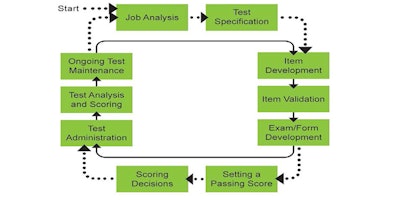
Food safety and security is a fundamental and enduring public health mandate, and proper food handling throughout the food supply and delivery chain is essential to help ensure public health. In recent years, and as all indications point in future years, growing concern over food safety has prompted greater scrutiny of safe food handling practices. For individuals, businesses and food manufacturers of all sizes, the pressure is greatest to uphold high standards for food safety and security. If they fall short, there can be public health impacts, as well as business impacts, that could include loss of reputation, revenue and business.
So, how do manufacturers ensure they are best prepared in a food safety landscape that is ever-changing — sometimes predictably as with the U.S. Food and Drug Administration’s (FDA) Food Code updates and, sometimes, unpredictably when there is an incident of foodborne illness? With comprehensive and reliable exams developed by qualified companies, employees in the field — ranging from food manufacturers to handlers — learn to do the right thing at the right time and better protect the public.
Prometric, a leading testing and assessment authority for the food safety industry, understands that food safety certification programs must be based on — and built to — the Food Code, and should be flexible and adaptable to changes with the current state of food safety. In its recently published Industry Report, Leave Nothing to Question: Develop the Right Food Safety Assessment Program, Prometric explains why food safety certification exams must:
- Allow those who handle food to demonstrate their knowledge and qualifications accurately and fairly
- Assure employers that their employees have the skills to do the job that they have been hired to do
- Offer the means for those in the food, restaurant and retail industries to be active participants in the safeguarding of public health and safety
The Industry Report identifies three key success factors that companies involved in the food supply chain need to consider when developing an effective food safety assessment program.
Success Factor One: Rely on a Quality-Driven Food Safety Assessment Provider
When exams are created and implemented properly, they are predictive of safe food handling from farm to table, and they properly equip food handlers to safely do their jobs. Food manufacturers today must recognize the importance of choosing the right partner who can provide quality-driven assessments that adhere to today’s industry standards.
An effective food safety assessment provider must know how to:
- Collaborate with Subject Matter Experts (SMEs) to keep assessments current and relevant
- Meet industry standards and adhere to best practices for testing, exam design and results evaluation
- Maintain a robust item (question) repository to safeguard exam content and vary items to specific scenarios
- Invest in continuous evaluation on performance of items, before and after they are finalized, to verify they accurately measure test takers knowledge and capability
Success Factor Two: Develop Rigorous, Reliable and Relatable Exam Content
Using a trusted food safety assessment provider that consistently develops rigorous, reliable and relatable assessments is the only way to confirm that individuals have the knowledge and skill set to perform in the workplace. To create reliable and accurate exams, food safety assessment providers should continuously invest time and resources to ensure their current items are relevant. They must also write new items to be responsive to current market needs, adhere to ANSI standards, reflect the FDA Food Code and be inclusive of diverse professional interests to better serve restaurants, retail establishments, grocers, culinary schools, manufacturers and processors.
The most effective way for food safety assessment providers to guarantee the relevance and accuracy of exam items is by using a rigorous step-by-step exam creation process that ensures exams are asking questions that align to industry standards and provide information that individuals can leverage in the workforce.
 (Graphic 1: Exam Creation Cycle) A quality-driven food safety assessment provider should incorporate these steps to help ensure exams are complete and accurate.
(Graphic 1: Exam Creation Cycle) A quality-driven food safety assessment provider should incorporate these steps to help ensure exams are complete and accurate.Success Factor Three: Create Exams that Properly and Securely Assess the Workforce
It is not enough for food safety assessment providers to develop items and exams — they must factor in best practices for test-taking and learning, as well as understand how the workforce processes information and operates. By combining all of these factors, food safety exams function as an effective two-way communication tool, sharing knowledge with test takers, while also collecting information about the exam performance and skillsets of the workers.
Every exam should:
- Solicit industry input
- Use interactive scenarios
- Create a feedback loop and adaptable exams
As the workforce continues to change, so should food safety exam and certification programs.
There’s No Second Guessing What’s Safe
Safe food handling is the key to preventing and avoiding foodborne illness and protecting the public from food safety incidents. Quality-driven food safety assessment providers must adopt a best-practices approach for creating exams and certificate/certification programs that demonstrate a thorough understanding of behavioral learning, the job skills required and compliancy with the latest FDA Food Code. These safeguards ensure those who work in the food service industry have mastered the basic skills and principles necessary to protect the public against foodborne illness in both the retail and restaurant environments.
“Time and time again the importance of reliable testing has shown how it can assess both the effectiveness of your training and the knowledge your employees have retained from that training. Being able to apply food safety learnings to keep the public safe is one of the most critical measures that will contribute to your long-term business success.”
– Holly Dance, Vice President, Food Safety Testing and Assessment Solutions, Prometric
It is critical to use a reliable food safety assessment provider to ensure that test takers are capable of safely executing their jobs. An effective exam should have a content creation process that follows globally recognized testing and assessment standards, features extensive item review and adheres to a best-in-class approach for test administration, delivery and maintenance.
For more than 50 years, Prometric has been a leader in the testing and assessment industry with extensive experience in developing new and evolving certification and licensure programs. With Prometric’s rigorous and extensive exam creation methodologies and understanding of behavioral learning, test takers are more prepared to help guarantee food safety success in the workplace as a means to prevent incidents from happening in the first place. For more information and to download the full industry report on this subject, visit www.prometric.com/FoodSafetyReport.






















